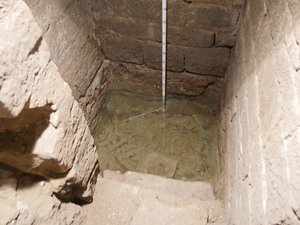The Mikwe or Mikvah - Living water for ritual cleansing
Very special, barely visible examples of the diversity of Jewish life were the ritual immersion baths (Mikwaoth) that used to be in almost every Jewish community (e.g. in Trendelburg, Hofgeismar, Grebenstein, Meimbressen, Hoof, Zierenberg, Naumburg, Wolfhagen and Volkmarsen).
Most of these facilities were irretrievably destroyed or poured over with concrete in the course of violence during the Nazi era or later through demolition and renovation measures. In Trendelburg, a very old mikvah was uncovered a few years ago and in Wolfhagen at the end of the village towards Schützeberg a board and a spring water basin reminds of the Judenbad that used to exist here.
The extraordinary excavation results in Volkmarsen show that, with careful handling of historical building fabric and appropriate research work, we can still rediscover unique, completely forgotten cultural monuments and make them accessible to the public.
The rediscovered unique mikvah in Volkmarsen has been excavatedin 2013. More than thirty years ago, Ernst Klein had already dealt with the medieval cellars and stone works that still existed in Volkmarsen. As part of his many years of research on the history of the Jews, he was able to prove that some Jewish families were resident in Volkmarsen much earlier than stated in the specialist literature and in the city chronicle.
Based on this, he concluded that long before the well-known construction of a synagogue with a mikvah around 1827, a prayer room and a mikvah must have been available for the Jewish community.
During his research in various archives, he discovered that the house at Steinweg 24 with the exceptionally beautiful vaulted cellar from the first half of the 13th century still belonged to the Jewish Hüneberg family 150 years ago. Gradually, the assumption grew that this might have been a meeting room and a ritual bath in the past.
In 2013, the owner of the house granted permission for test excavations below the basement floor, and at the beginning of October 2013 Ernst Klein began to work together with the honorary monument conservationist Peter Kirschbaum from Warburg and Joachim Geritzen.
After picking up the recently built stone pavement, they first encountered rubble, stones and heaped earth, until the upper edge of a vault and, further down, a worked sandstone masonry with two built-in storage compartments became visible.
Everything indicated that they had indeed discovered an old mikvah. After visiting the excavation site by Dr. Letter and Dr. Sippel from the State Office for Monument Preservation, the Institute for Building Research and Documentation from Marburg was commissioned to carry out detailed studies.
In cooperation with experts, the completely preserved vaulted shaft micveh was then exposed to a depth of 300 cm. In the plunge pool there is clear, constantly renewing water, as it has been prescribed by the Jewish commandments since ancient times.
Wooden parts found in the lower part of the immersion bath carved into the rock (presumably wall cladding on the edge of the pool) now provide information about the probable age of the system:
Based on the dendro-chronological investigations, we can assume that the oak and beech wood was felled before or around the year 1500.
The processing of sandstones and an arched portal in the basement area also indicate to a point in time before 1500.
The overall analysis of the building fabric shows that as early as the end of the 15th, but no later than the beginning of the 16th century, an immersion bath in Volkmarsen was an integral part of the Jewish community as a place for ritual cleansing.
This rediscovered shaft mikwe, built in the late Middle Ages, is therefore around 500 years old; according to a research report, no comparable systems are known in Hesse.
In Hesse, the mikvah in Friedberg, which was built in 1260 and, due to the altitude of the city, leads over many steps to a depth of 28 m, is even much older.
Extracts from the 60-Page Investigation Report of the free Institute for Building Research and Documentation e.V. in Marburg
Architectural historical study in Volkmarsen, Steinweg 24 Cellar in the rear building with mikvah: ... Result of construction phase I of the cellar examined:
“It is obviously a building from the early phase of urban development. Most likely the date for the construction of the cellar is the 30's or 40's of the 13th century.
... The vaults in the southern part of the cellar are supported by a round pillar, the capital of which is decorated on three sides with identical ornaments made of semicircular shields. In the northern part, an octagonal pillar was installed in construction phase II. The basement is accessed through a basement neck with a round arched gate in the northwest corner. The joint cut used for the gate corresponds to gates that were built in the 2nd half of the 14th and 15th centuries. Some traces of processing point to the middle of the 15th century. The reconstruction work in the cellar was probably carried out in the second half of the 15th century. The renovation may be related to the destruction by the troops of the Landgrave of Hesse in 1477. In construction phase III, a mikvah was installed in the south-west corner of the cellar. The shaft of the mikvah is covered with a segment-arched barrel vault with apex in east-west direction, the upper edge of which is approximately at the level of today's floor.
... The masonry consists of relatively flat, mostly rectangular stone, which are now 0.11 m and a maximum of 0.17 m high and have been carefully walled up.
... Three layers of stone above is a "niche stone" walled up on edge. It is a cuboid 0.35 m high and 0.28 m wide, in which a recess 0.27 m high and 0.20 m wide is carved.
... From the quarter-circle projection, the south wall of the mikvah continues to the south-east corner of the shaft over a length of 1.30 m. From its upper edge it extends ten layers of stone down to the level of a step, which in a sense formed a kind of threshold to the entrance to the mikvah. Below that begins the red sandstone rock in which the lower section of the shaft is carved. The actual bottom of the diving pool is then about 0.70 m lower. Another niche is built in above the threshold of the entrance, directly on the swinging part of the masonry. The dendro-chronological examination of some woods from the plunge pool. For the purpose of dendro-chronological dating of the timbers recovered from the filling of the plunge pool, a total of five objects were selected that may be remnants of the plunge pool cladding, such as three selected boards 16 cm wide with edge profiles on both sides, grooves and tenons. The result is quite astonishing: All of the examined and dated woods had their growth phase in the second half of the 14th century and in the 15th century. The last surviving annual ring of sample 3 dates to 1449. The earliest possible fall year is 1465 + 10 / -7.
Construction phase III - The installation of the mikvah in the early modern era The builders of the mikvah had chosen the south-west corner of the basement as the future location for the mikvah. The plunge pool of the mikvah is not particularly large, but with a volume of (depending on the groundwater level) 800-1000 l it corresponds to the ritual regulations for a functional groundwater mikvah.
Even if this mikvah is comparatively small, in the broadest sense it still seems to be linked to the high and late medieval shaft mikvah in its architectural type. The monumental mikvahs in the Rhineland, above all Worms, Speyer and Cologne, have in common that they have a vaulted shaft above the plunge pool. If you look around in Hessen for comparative examples, you won't find anything.
All older mikvahs that are dated to the 17th or 18th century have no shafts, but are so-called basement mikvahs.

